Blues Reviews Dec 2020/Jan 2021
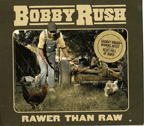 Bobby
Rush
Bobby
Rush
Rawer Than Raw
Deep Rush Records 2020
Is there something magical that confers longevity with vitality to so
many bluesmen? How many of them visited the famed crossroads and made
an old-age pact with the devil? Pinetop Perkins, Honeyboy Edwards, and
Robert Lockwood Jr. all lived into their 90s. Still active performers
include 92 year-old Jimmy Johnson, John Mayall at 86, Buddy Guy at 84,
Taj Mahal at 78, and youngster Jimmy Burns at 77. Not to be upstaged is
Bobby Rush, 86 years old and still releasing quality albums, even though
he has nothing left to prove. A member of the Blues Hall of Fame and a
Grammy winner, winner of a dozen Blues Music Awards and many more nominations,
Rush has played with luminaries ranging from Elmore James, Freddie King,
and Luther Allison in the 1950sand 1960s to Alvin Youngblood Hart and
Dr. John more recently.
Rush is a man of many talents. He writes songs which are idiosyncratic
and witty, plays both guitar and harmonica skillfully, sings compellingly,
and for decades has fronted a risqué, soulful, and danceable revue
popular on the touring “Chitlin Circuit.” This, his umpteenth
release, harks back to 2006’s “Raw”: the sole performer
is Rush, plying guitar, harp, and voice as he presents eleven tunes in
homage to his Deep South roots.
The five original compositions begin with “Down in Mississippi,”
an ode to his adopted home state. (He was born in Louisiana but lives
in Jackson, MS.) The remaining originals adhere to Rush’s usual
concerns: travail, rejection, and especially sex. “Let’s Make
Love Again” boldly announces the singer’s amorous desire,
and “Let Me in Your House” reprises the theme with humorous
lyrics: “If I can’t sleep in your bed/Let me sleep down here
on your floor/If I walk in my sleep/ You’re the only one will ever
know.” “Garbage Man” continues with sly innuendos; it’s
basically a cover of Eddie Boyd’s classic “Five Long Years”
with modified lyrics.
Although it’s a cover of a Willie Dixon song, “Shake It for
Me” also deals with sex; those who have seen one of Rush’s
live revues, replete with well-endowed dancers twerking by his side, will
be unsurprised by the lyrics “Well you went away baby/Got back a
little too late/ I’m gonna find me another woman/Shake like jelly
on the plate.” There are well chosen covers of Robert Johnson’s
“Dust My Broom,” Skip James’s “Hard Times,”
Howlin’ Wolf’s “Smokestack Lighting,” and Sonny
Boy Williamson’s “Don’t Start Me Talkin’.”
To his credit, Rush makes them his own, hewing to a twelve-bar blues structure
but varying tempos and lyrics from the originals, morphing them from electric
band blues to back porch country versions. His minimalist approach, with
funky harmonica and acoustic guitar and his insinuating, raspy vocals,
is a delight.
Judging by this release, Bobby Rush is far from being done.—Steve
Daniels
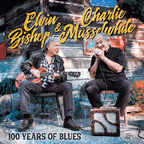 Elvin
Bishop & Charlie Musselwhite
Elvin
Bishop & Charlie Musselwhite
100 Years of Blues
Alligator 2020
“No twitters, no tweets” go the lyrics of one of the nine
original songs that blues veterans – and legends – Elvin Bishop
and Charlie Musselwhite have crafted for their new Alligator release.
It’s hard to believe that these two septuagenarians are virgin album
collaborators, but the wait was worth it. They have produced a set of
a dozen tracks replete with expert musicianship and a vibe emanating mutual
affection and musical affinity.
The tracks comprise traditional twelve bar blues without frills. There
are no drums, demonstrating, as did John Mayall in his classic 1969 album
“The Turning Point,” that solid rhythm can be delivered without
them. On four tracks bass guitar is played impeccably by ubiquitous producer
Kid Andersen, and Bob Welsh girds the proceedings on all tracks with alternating
piano and second guitar. Kudos to Welsh, a renowned West Coast session
player who is superb throughout.
Several of the songs allude to Bishop and Musselwhite’s origins
in Oklahoma and Tennessee respectively, to their shared musical maturation
in Chicago in the early 1960s, and to their career longevity. “Birds
of a Feather,” the opening cut, is upbeat and emphasizes Elvin and
Charlie’s ties to each other and the blues community, Bishop handling
the vocal. Charlie assumes the vocal seat next on a pithy cover of Roosevelt
Sykes’ “West Helena Blues,” and then it’s back
to Bishop for the topically relevant “What the Hell?” The
sly and sardonic lyrics are characteristic of the witty writing still
to come. Even the covers provide laughs: on “Help Me,” made
famous by Sonny Boy Williamson II, Charlie lasciviously intones the great
double entendre line “I don’t feel like sleepin’/I just
feel like lyin’ down.”
As I made notes while listening to the album, I put a star next to each
track that I particularly liked. I ended up with twelve stars! Bishop’s
guitar leads are stinging or plaintive, as required by the song. His singing
is more accurately characterized as talking blues, but on the cover of
Leroy Carr’s “Midnight Hour Blues” he shows that he
can also hit the more challenging mark vocally on a slow, dirge-like blues,
while also providing a brief but moving guitar solo. Musselwhite’s
drawl-inflected singing is consistently appealing; he always sounds laid
back, never in a hurry, but also “right there.” The harmonica
virtuosity that has won him innumerable awards is sterling; his harp tone
is deep and mellow, he hits the high registers with aplomb and slides
back effortlessly to low notes, and his destination is never clear but
he always gets there.
OK, I will cite one track which is my favorite: “Old School,”
written by Bishop and Willie Jordan, which appeared previously on Bishop’s
2014 album “Can’t Even Do Wrong Right.” It’s a
danceable shuffle utilizing the talents of all four musicians and inducing
multiple chuckles, including the lyric “Don’t send me no email/Send
me a female.” Bolstered by Andersen on bass, it features several
bars of Bishop and Welsh on guitars and Charlie on harp, all playing in
sync - that sent shivers of delight up my spine. It even has some John
Lee Hooker guitar licks near the end.
This is blues at its best. Let’s hope that Bishop and Musselwhite
remain on top of their game for many more years.—Steve Daniels
 Eric
Johanson
Eric
Johanson
Below Sea Level
Whiskey Bayou Records
whiskeybayourecords.com
After the Louisiana Cajun and Mississippi Hill Country Blues of his 2017
album “Burn It Down,” produced by Tab Benoit, Eric Johanson
- guitarist, songwriter and vocalist - moved to New Orleans and Nola Blue
Records and to the production of Luther Dickinson to record his 2020 album
“Below Sea Level.” With Cody Dickinson on drums and Terence
Grayson of the Victor Wainwright Band on bass guitar, the band recorded
live in the studio - and the tracks jump from the rails like a runaway
train. The producer, Luther Dickinson, lead guitarist and vocalist for
the North Mississippi Allstars, simply had to get out of the
way and make sure there was fresh coal in the engine. There’s very
little overdubbing, the guitar sounds are unaffected by modern technology
and they are played by Johanson with undeniable force and uninhibited
strength. Recorded at Zebra Ranch Studios where Jim Dickinson, Luther’s
father, has produced music by (among others) the North Mississippi Allstars
and David Kimbrough. Dickinson has been known to refer to this kind of
original music as “Memphis Underground.” For those yearning
for more original Americana and Blues Rock, this album sits right in there
with modern production values of EQ, rum? sound and reverb, but with a
vintage feel of the early days of Cream and ZZ Top.
The album opens with “Buried Above Ground” and Johanson declaring
“don’t tell me about the devil man, I live below sea level”
driven by a more exotic (imagine Bo Diddley’s drummer chewing gravel
while he played) drum figure than we expected. The song “Hammer
on the Stone” recalls the classic “Hear My Train a’Comin’”
and breaks free of it once the vocals kick in. “Never Tomorrow”
takes off with a rock riff and lots of vocal stops that could have been
convincingly demoed by early Led Zeppelin (although at a much slower tempo).
My guess is that “Open Hearted Woman” is the sharpest arrow
in Johanson’s quiver. Here, angst-ridden lyrics, played over a mid-tempo
blues, are both relaxed and menacing. “River of Oblivion”
shows off some slide guitar lurking under the vocals that will keep die-hard
blues fans on the edge of their seats. The 12 original tracks on this
sophomore release prove well worth the wait, after the previous album.
I’m looking forward to hearing more from this unique musician. To
find out more about Eric and the album “Below Sea Level” visit
www.ericjohanson.com— Conrad Warre
 Peter
Veteska & Blues Train
Peter
Veteska & Blues Train
Grass Ain’t Greener On The Other Side
peterveteskabluestrain.com
Peter Veteska is a NYC area-based guitar slinger/vocalist/songwriter and
is no stranger to this magazine or the East Coast blues and festival scene.
Grass Ain’t Greener On The Other Side is his fifth release, the
previous four under the band name Peter V Blues Train. He recently formed
Peter Veteska & Blues Train with the only holdover from the original
band being drummer Alex D’Agnese. Veteska felt he was straying from
the pureness of the blues on his previous albums, “injecting some
jazz and funk” in his own words. Grass Ain’t Always Greener
On The Other Side demonstrates a conscience effort to stay true to the
blues. And a hard rockin’ blues is what we get here.
“Am I Wrong Pretty Baby” opens with some boisterous blues
harp from Mikey Junior. A fine solo by Veteska is followed by some serious
B3 organ soloing by special guest Jeff Levine, whose sublime playing sparkles
throughout the recording, raising the level of the entire band. “Baby
You Got What It Takes” has a Texas shuffle feel to it as Jen Barnes
duets with Veteska, adding a nice element to the mix. Most of the songs
are written by Veteska but the covers “Heartbreaker” and “You
Don’t Love Me” are definite highlights. Ray Charles’
“Heartbreaker” features a second guitar by Roger Girke who
trades verses with Veteska and the souped-up Allman Brothers Fillmore
East vehicle “You Don’t Love Me” is a gas. Blues Train
member Coo Moe Jhee is solid on the bass throughout the album, holding
down the low end with precision and drive. Longtime Veteska associate
Joeseph DeMaio recorded and mixed this great sounding collection, with
Veteska producing and arranging, at Shore Fire Recording Studio in Long
Branch, NJ. The title track closes the set, featuring a soaring wah wah
solo by the leader and more B3 fireworks from Levine. Peter Veteska’s
vocals are always powerful and heartfelt. His Stratocaster is always tough,
mirroring his vocals, avoiding clichés and arriving at some nice
unexpected turns of phrase. A solid effort from beginning to end. —Bob
Monteleone
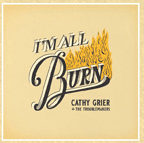 Cathy
Grier + the Troublemakers
Cathy
Grier + the Troublemakers
I’m All Burn
CG Music Works
Singer/guitarist/songwriter Cathy Grier has worn many hats during her
lifetime: producer, filmmaker, social activist and New York City busker
(she once earned the moniker NYC Subway Girl). The Connecticut native
has played around the globe. Among her many adventures, she toured Germany
with the French group Parallel Vif and co-wrote “Misery” for
the artist Indra, which became a #1 French dance hit. She settled in the
beautiful Sturgeon Bay area of Wisconsin in 2016, after residing in NYC
for the previous twenty years, where she played (as a member of the group
Troia/Grier) at such legendary venues as Folk City, the Lone Star Café
and the Bitter End. She has found the Sturgeon Bay/Door County very welcoming
to her talents, performing at festivals and winning many awards and forming
her band the Troublemakers in 2017.
I’m All Burn basically encompasses her time in Wisconsin, which
features fifteen originals and one cover, Bobbie Gentry’s classic
“Ode to Billy Joe.” The album was recorded and co-produced
(with Grier) by Steve Hamilton at Milwaukee’s Makin’ Sausage
Music. Four songs were written in collaboration at Sturgeon Bay’s
Holiday Music Motel during the annual Love On Holiday songwriting week.
A total of twenty (!) musicians/singers appear on I’m All Burn,
but the album is a focused affair. Troublemaker band members (Tony Menzer:
bass, Jamey Clark: drums, Jim Ohlschmidt: guitar and Larry Byrne: keyboards)
play on almost all the tracks. “Honorary Troublemaker” Greg
Koch makes some notable contributions on slide and lead guitar. A 3-piece
horn section led by saxophonist Andrew Spadafora spice up five of the
songs with Grier’s tasty arrangements. Most songs feature male and
female background vocals which lend a gospel feel to the songs. Grier’s
guitar solos pop up throughout the recording, always melodic and understated.
Her voice is mostly laid back, never overpowering the songs or showboating,
but always pleasant and clear, reminding this reviewer at first of Carole
King but upon further listening hears a strong Bonnie Raitt influence,
which is never a bad thing. The material on I’m All Burn varies
from some slow blues shuffles like “Get Me Away” and “Backyard
Blues” to mostly soulful ‘70s mid-tempo grooves. No modern
devices like synthesizers, drum loops and samples are present anywhere,
making the entire project sound timeless and organic. I’m All Burn
is a generous but not over-weighted offering of solid songwriting and
well-played arrangements featuring the considerable talents of Cathy Grier
and her cast of some of Wisconsin’s finest musicians. A solid listen!
– Bob Monteleone
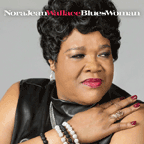 Nora
Jean Wallace
Nora
Jean Wallace
Blues Woman
Severn CD
Passionate blues singer and prolific songwriter Elnora Jean Wallace was
born in 1956 in Greenwood, Leflore County, Mississippi to a musical family,
the seventh of sixteen children of a blues singing, sharecroppingfather
and whose grandmother ran a juke house. Relocating to Chicago at age nineteen,
she eventually joined Jimmy Dawkins’ band and released her first
single “Untrue Lover” on Dawkins’ own Leric label. The
powerhouse vocalist also toured and recorded with Dawkins, released her
first solo CD, Nora Jean Bruso Sings The Blues, on Red Hurricane Records,
and performed, in “show-stopping” fashion, with Dawkins at
the 1989 Chicago Blues Festival. 2004 saw the release of her BMA-nominated
and critically lauded CD, Going Back To Mississippi, as well as her leaving
the scene to take care of her ill mother. This new album, 16 years on,
was produced by Severn head honcho, David Earl (who also plays guitar
on four tracks) and showcases the label’s A-list team of musicians
including guitarist Johnny Moeller, bassist Steve Gomes, organist Kevin
Anker, harmonica ace Steve Guyger, keyboardist/songwriter Stanley Banks
and drummer Robb Stupka with special guest Kim Wilson playing some tonally
sharp harp on “Rag And Bucket,” a Banks composition. Picks
include the Koko Taylor-INSPIRED title track “I’m A Blues
Woman,” an inviting “Dance With Me,” an easy rocking
cover of Syl Johnson’s classic “I Can’t Stop,”
the reflective “Victim” and a testifying “Look Over
Yonder.” Welcome back Nora!
Gary von Tersch
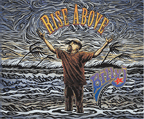 Billy
J
Billy
J
Rise Above
Billyjjams.com
Rise Above is singer/guitarist/songwriter Billy J’s debut CD but
has the confidence of the longtime musician Billy is, who as a young man
in South Jersey opened up for such rock luminaries as Bruce Springsteen
and Cinderella and eventually settled into the vast Florida music scene
as an engaging performer. Rise Above was recorded mostly live in the studio
with an all-star band. Two great rhythm sections perform on the album:
the late, great drummer Yonrico Scott with bassist Todd Smallie (both
longtime Derek Trucks Band alumni); and Scott teamed with former Royal
Southern Brotherhood rhythm partner Charlie Wooton, whose excellent solo
album Blue Basso was reviewed on these pages a year ago. Also, Jeremy
Baum handles keyboards and J. Robert appears on violin and steel drums
along with Stephen “Buzzy” Krist on percussion. Billy J handles
all guitar duties with taste and an attitude when called for. The album
was produced and mixed at Broccoli Rabe Studios in Fairfield, NJ by Big
City Rhythm & Blues magazine contributor Dave Fields.
Rise Above is a mix of mostly hard-hitting rockers, plus a couple of acoustic-based
power ballads (the title track and “She”), a slow blues (“New
Car,” which has some Jimmy Page-influenced solo lines) and even
a reggae tune (“Push Push”)! The rocker “She’s
Mine” starts things off with a funky guitar intro, a catchy chorus
hook with snarling leads throughout. “Sweaty Melons” also
has a funk rock groove with some potent B3 organ stabs. The one cover
on the album, Harry Chapin’s “Cat’s in the Cradle,”
is a clever and rocking re-working of the ‘70s classic. “Push
Push” showcases the band’s versatility and features a catchy
guitar hook. “My Baby’s Blu” is a highlight, with a
hard rock shuffle supporting a great rhythm guitar hook. All the tracks
contain Billy J guitar solos, but the songs come first. All the tunes
are well written; the solos exist to support the song, not the other way
around. Billy J’s guitar style is steeped in 1970’s rock.
No obvious cops of any particular guitar heroes although he favors a fast
vibrato that reminds this reviewer of Jorma Kaukonen in his acid rock
phase of electric Hot Tuna. In conclusion, this is a fine sounding collection
of rocking tunes that should satisfy both the classic rock and casual
blues fan alike. – Bob Monteleone
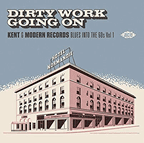 Dirty
Work Going On
Dirty
Work Going On
Kent & Modern Blues Into The ‘60s
Volumes 1
If I Have To Wreck L.A.
Volume 2
Ace Records
These two volumes, combined, feature fifty tracks from the deep vaults
of the West Coast-based Bihari Brothers’ Modern and Kent record
labels that had a slew of hits by the likes of B.B. King, John Lee Hooker
and Elmore James among many others in the 1950s. “But the blues
didn’t stop at the end of the 50s and, as soul music ruled the charts,
the grittier end of black music was well represented by the nine artists,
old and new, on the Volume One compilation—great guitar playing
to the fore,” as liners author Dick Shurman puts it. The nine are
Texas bluesman/pimp Fillmore Slim (check out “Fast Gun Annie”);
quintessential 60s blues artist King Solomon; itinerant, B.B. King-influenced
Little Joe Blue; the legendary T-Bone Walker; another B.B. King disciple
Larry Davis; Lowell Fulson-influenced “Flash” Terry; bulldozing
tenor man “Big Jay” McNeely; Little Johnny Taylor disciple,
big-voiced Stacy Johnson and, to bring it all back home, one track by
B.B. himself, the fountainhead of this CD—“Down Now”
concerning his IRS troubles, shades of Willie Nelson. Volume Two keeps
the focus on Texas but draws a bead, strictly and delightfully, on the
downhome, house-party, gutbucket blues approach—with the harmonica
replacing the horns and the angular shadows of Lightnin’ Hopkins
and John Lee Williamson looming large and is centered around eleven sturdy
sides from Willie Headen and the mysterious Willie “Stinky Butt”
Garland—favorites from the pair include the title tune, an eyes-wide,
searing, guitar-driven slow blues travelogue of the Los Angeles area along
with a rousing, Elmore James-styled shuffle, “Hey Baby,” and
“Black Widow Spider,” with Garland’s throwback harp
style to the fore. Five other artists add to the fun—force of nature,
Big Mama Thornton, with the slow wailer “Before Day,” Lowell
Fulson with his utterly laid-back, slicing guitar-infused “Blues
Pain,” South Central performer and club owner Smokey Wilson, Lightnin’
Hopkins protege Luke “Long Gone” Miles and great songwriter
Model T Slim with his accelerative classic “Somebody’s Done
Hoodooed The Hoodoo Man.” Top shelf stuff, each with nifty booklets.—Gary
von Tersch
 Vanessa
Collier
Vanessa
Collier
Heart on the Line
Phenix Fire Records
Vanessa Collier sings, plays alto, tenor, soprano and baritone saxophone,
clavinet, organ, guitar and percussion. She writes her own material and
has self-produced her album entitled “Heart on the Line” on
the Phenix Fire Records label. This is the Berklee graduate’s fourth
album release and comes hot on the heels of her winning the 2020 Blues
Music Award (BMA) for Instrumentalist of the year - for the second consecutive
year. Collier usually plays and tours with some of her Berklee peers.
The album features William Gorman on keys, Quinn Carson on trombone, Nick
Stevens on drums and shuitar - yes I had to look that up –the ‘shuitar’
is an acoustic guitar converted into a percussion instrument with a variety
of sounds ranging from snare to bass, and can be played by hand or with
brushes. Also appearing is the phenomenal blues guitarist Laura Chavez,
Doug Woolverton on trumpet and C.C. Ellis on bass guitar. The songs cover
a wide range of styles, so it’s impossible to nail them down to
a narrow musical niche. You have to imagine a band that can play sixties
soul convincingly, and then switch to delta blues or gutbucket funk. The
album is expertly performed and produced – the songs well-written
and cliché-free with a supporting musicianship that is both sensitive
and assertive when necessary. The song “I Don’t Want Anything
to Change” is a stand-out with an all-too brief gorgeous saxophone
solo and reminiscent (in a good way) of some of Bonnie Raitt’s best
known ballads. The album opens with the high energy funk of “Superbad”
– matched later with a nice take on the Randy Newman classic, “You
Can Leave Your Hat On.” Laura Chavez’s guitar standout tracks
are “Take a Chance on Me” where she delivers an overdriven
growl, later followed by the down-tempo blues ballad titled “Weep
and Moan” where she delivers a Ronnie Earl-influenced solo, which
is unaffected but for some reverb plangent single-coil guitar soulful
ornamentation. Collier plays a mean resonator guitar herself on the third
track on the album “Bloodhound.” It’s rumored that Chavez
and Collier might record an album of duets sometime in the future.
Originally from Dallas, Texas, Collier started performing when she was
only eleven years old and has toured around the world. She’s played
with Annie Lennox and Willie Nelson and toured backing Joe Louis Walker
in 2012 and 2013. Collier’s band has been off the road since March
of 2020 and she has spent the time constructively writing and arranging
and producing an album that is both excellent and impossible to categorize.
If you’ve never had the chance to witness Collier live, this album,
as good as it is, belies the understanding that on stage she takes total
command and earns the instant respect of both her audience and her peers
– often charging offstage and into the audience leading the band
in spontaneous makeshift musical parade through the venue whether it’s
a club, theatre or festival. You should catch her and her band live as
soon they hit the road.— Conrad Warre
 Andy
Cohen
Andy
Cohen
Tryin’ To Get Home
Earwig CD
Andy Cohen is a master finger-style guitarist who has been characterized
as “a walking, talking folk-blues-roots music encyclopedia.”
During the fabled Sixties Folk Revival, he was transfixed by the music
of Big Bill Broonzy and the Jim Kweskin Jug Band and, after hearing South
Carolina’s legendary Reverend Gary Davis perform as a teenager,
decided to dedicate his life to studying, performing and promoting the
traditional blues and folk music of the pre-World War II era. At an Andy
Cohen concert (and on this new CD) one can count on hearing blues deeply
rooted in Mississippi, the Piedmont region, Memphis and Chicago along
with some gospel, ragtime and original tunes. Knockout numbers include
a great take on Blind Boy Fuller’s hit song “Step It Up And
Go,” an ingenious revamp of Mississippi John Hurt’s “Talkin’
Casey” that includes sound effects courtesy of Furry Lewis and Blind
Blake, an engrossing version of Bob Dylan’s poetically reflective
“Bob Dylan’s Dream,” penetrating versions of a pair
of Rev. Davis songs (“Death Don’t Have No Mercy” and
“Tryin’ To Get Home”), a jumping recall of Clarence
Williams’ oft-covered “I Ain’t Gonna Give You None Of
My Jelly Roll” and a bones-accompanied update of Blind Blake’s
“West Coast Blues.” And if you’ve got kids, Cohen also
has a new children’s CDs available (Small But Mighty: Songs For
Growing People) with smile-inducing songs like “Uncle Stinky,”
“The Brand New Baby” and “Happy-Go-Lucky.”—Gary
von Tersch
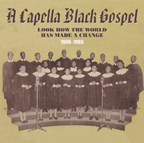 A
Capella Black Gospel
A
Capella Black Gospel
Look How The World Has Made A Change: 1940-1969
Narro Way CD
As liners author Ray Templeton assuredly reflects: “These days,
the idea of music made just by unaccompanied voices can seem quaint and
conservative, but in the first half of the twentieth century, vocal group
singing was one of the most progressive and inventive of African American
arts. In the absence of instruments, its exponents had to work that much
harder to stay ahead of the game, to ensure that their own distinctive
sound grabbed and held the attention of audiences and record buyers. At
its best, a cappella singing is deeply indigenous in character, but it’s
not some kind of distinctive folk tradition.” This great-sounding,
eighty track 3-C D compilation, courtesy of the preeminent Per Notini,
contains several un-reissued recordings by famous groups like the Soul
Stirrers, the Pilgrim Travelers, the Fairfield Four, the Famous Blue Jay
Singers, the Wings Over Jordan Choir, the Georgia Peach, the Southern
Sons and the McNeil Choir. All of which are spectacularly innovative as
well as illuminating. Many tracks are devoted to less well-known names
but they all, unfailingly, certainly get their messages across. Let me
cite a few of my particular favorites— the National Clouds Of Joy
(with a frenetic “Does Jesus Care”), the Camp Meeting Choir
Of Winston-Salem, N.C. (the minor harmonies on “Lord Search My Heart”
are mesmerizing), the L&N Gospel Singers (those big long notes on
“Lord, You Been So Good To Me” ensnare the ear), the Sunset
Jubilee Singers Of Alameda (whose mellow yet rocking rhythm on “My
God Is Real” ends on an unexpectedly delightful final chord), the
Original Kings Of Harmony (their slow-burning “I’ve Got A
Mother Done Gone On” is an eyes widener) and the Sam Cooke-influenced
Heavenly Kings, with their riveting rendition of their testimonial “Every
Living Thing.” As Templeton quite accurately opines: “This
is the most important post-war quartet reissue anthology in more than
thirty years.” He continues: “On the absence of instruments,
its exponents had to work that much harder to stay ahead of the game.”
The real deal!—Gary von Tersch
 Big
Harp George
Big
Harp George
Living in the City
Blues Mountain Records 2020
In the four years since I reviewed his 2016 album “Wash My Horse
in Champagne,” San Francisco Bay Area bluesman George Bisharat has
been busy. “Uptown Cool,” released in 2018, garnered fond
reviews, and his new album will almost certainly pile up the accolades
as well. Let me join the admirers.
It helps that Big George has established a close musical rapport with
a group of the finest musicians on the West Coast. Among them are producer
and keyboard expert Chris Burns, widely acclaimed guitarist Kid Andersen
- alternating here on guitar and bass - and drummer June Core, who provides
solid and snazzy backbone to the proceedings. Various bass players and
supporting singers are equally adept, and on six of the thirteen tracks
backing vocals are provided beautifully by the Sons of the Soul Revivers.
Special mention should be made of guitarist Charlie Baty. The former leader
of Little Charlie and the Nightcats until he abandoned touring a decade
ago, Baty collaborated on all three of George’s previous albums.
His untimely demise earlier in 2020 after recording here is a loss to
the blues community.
Baty was also an accomplished jazz guitarist, meshing well with Big George’s
jazz proclivities. This album is actually an amalgam of blues, jazz, and
world music, and sports a jaunty pace until the final three, more contemplative
pieces. George’s increased interest in world music is manifested
in several of the all-original tracks. “Enrique,” for example,
has a distinctly Brazilian flavor as it spins the tail of an impoverished,
hard-working immigrant. Its socially conscious message appears on several
other tunes, notably the last track, “Meet Me at the Fence,”
which is “dedicated to…all the young Palestinians yearning
for freedom in the Gaza Strip.” The cut is augmented by zither and
Arabic percussion. “Enrique,” similarly, benefits from employment
of violin and Paraguayan harp, both played hauntingly by Carlos Reyes.
Don’t worry: there is a lot of blues here. Among the inviting shuffles
are “Try Nice,” “Don’t Talk,” and “Copayment”;
the titles indicate the witty inventiveness of George’s lyrics.
“Copayment” hews most closely to a traditional twelve bar
electric blues outing, with George milking the high register on the harmonica,
Andersen and Burns delivering pithy solos, the horns and the Sons adding
plenty of soul.
Throughout the album there are crisp and creative solos by Big Harp, Andersen,
Baty, and Burns, but the emphasis is on smooth ensemble expertise rather
than individual virtuosity. George’s jazzy harmonica renderings
are expert, and as impressive as his singing, which maintains the spotlight;
his tenor vocalizing is supple and expressive.
Message to the Blues Music Awards: this will be a nominee for Contemporary
Album of the Year.—Steve Daniels
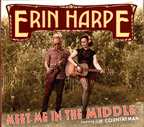 Erin
Harpe
Erin
Harpe
Meet Me in the Middle
Vizztone 2020
After the release of several albums with her electric band the Delta Swingers,
Erin Harpe has returned to her country blues roots with “Meet Me
in the Middle.” Harpe, a skilled fingerpicking guitarist and sultry
singer, won the 2019 New England Blues Artist of the Year award, and this
outing confirms her stature as a force in the blues world.
Recording in their Massachusetts abode in summer 2020 during the coronavirus
pandemic, Harpe and her bass player husband, Jim Countryman, dig into
ten tunes comprising a brief but satisfying set. It commences with the
Harpe composition “All Night Long,” a straightforward invitation
to a love tryst. Succeeding it are two more originals: “Hard Luck
Woman,” which easily could have been a 1930s Memphis Minnie song,
and the title track, with clever lyrics such as “You say yes, I
say no, You say stop, I say go; You’re not right, I’m not
wrong, We’re just singin’ that same old song.” It’s
probably no coincidence that the song appears in the middle of a divisive
political and cultural moment.
Next Harpe and Countryman cover a series of hoary and worthy tunes. Sippie
Wallace’s “Women Be Wise” and “I Hate That Train
Called the M&O” by Lucille Bogan (AKA Bessie Jackson) are both
given fine updated treatments; Harpe even supplements the former with
some kazoo renderings. “Rollin’ and Tumblin’,”
covered by myriad others ranging from Muddy Waters to Bob Dylan, displays
Countryman’s bass and Harpe’s slide meshing seamlessly. A
version of “Pick Poor Robin Clean” by the mysterious and sparsely
recorded Geeshie Wiley in the late 1920s is then followed by a measured
and mellow rendition of the gospel classic “When I Lay My Burden
Down.”
The penultimate track finds Harpe plucking and vamping on Memphis Minnie’s
“What’s the Matter with the Mill,” and the set ends
with another Harpe original, “One Fine Day,” a nice love ballad
with overdubbed harmonizing vocal by Harpe. Several other tracks also
sport similar delicious backing harmonies, and many benefit by Harpe’s
coincident foot percussion.
The album’s clean production allows appreciation of Harpe’s
soprano vocals, her guitar prowess, and her intimate musical rapport with
Countryman. Erin Harpe deserves to be accorded a spot along with Rory
Block and just a few others in the high echelons of acoustic blueswomen.—Steve
Daniels
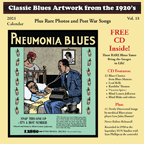 Classic
Blues Artwork From The 1920s Calendar
Classic
Blues Artwork From The 1920s Calendar
Various Artists
Blues Images
For nearly twenty years, John Tefteller has been committed to bringing
blues fans nonpareil replicas of original classic blues advertising artwork,
photographs and rare recorded music with his yearly calendars that also
include sample song lyrics, brief biographies and birth and death dates
of various artists. An enclosed CD features twelve Pre-War classics (one
for each month on the calendar) from early blues masters like “Peg
Leg” Howell (with his rollicking “Too Tight Blues”),
Meade Lux Lewis (with “Honky Tonk Train Blues,” the mother
of all piano blues recordings), Blind Lemon Jefferson (with the timely
“Pneumonia Blues”), Reverend D.C. Rice and his ardent congregation
on the spirited “The Angels Rolled The Stone Away” and the
late, great Victoria Spivey with a test pressing of her Halloween treat
“Witchcraft Blues.” Bertha Henderson with Blind Blake, Walter
Roland, Buddy Moss, Sonny Boy Williamson, Lead Belly, Ramblin’ Thomas
and Blind Boy Fuller are also at their best. The second half of the CD
is devoted to what many blues fans consider to be the Holy Grail from
Memphis’ legendary Sun Records—the long-lost, circa 1950,
laid-back yet wondrously primordial, initial blues recording session for
Sam Phillips’ label featuring the enigmatic singer/pianist Lost
John Hunter and his Blind Bats combo. There were no releases from this
session but it remains a significant moment in time as Hunter’s
rough and rugged vocals and wildly alert, James Booker-influenced piano
pounding, along with the talented teenage guitarist Herman Green, melded
masterfully. Highlights would begin with both takes of “Miss Thelma
Mae,” where Hunter is singing about (and looking for) his “copper
colored brown” that is followed by a couple takes of the decidedly
cheerless “You Gotta Heart Of Stone” (sharp guitar work) with
room in-between for boogie blues at its best on the lone take of “Lost
John’s Pinetop’s Boogie” along with the salaciously
pleading “Boogie For Me Baby” (“Lookie here baby, I
want you to talk back to me”) ,” two takes of an eventually
upbeat “Trouble Everywhere” followed by the warning-shot blues
of “Mind Your Own Business” (on two delightful Cecil Gant-influenced
takes) only to close with track 23 and the nostalgic “Back To Louisiana.”
WHAT! How can they all be highlights you say? All I can reply is to say
give it a listen. Big-eared Sam Phillips just warming up!— Gary
von Tersch
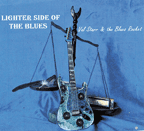 Val
Starr and the Blues Rocket
Val
Starr and the Blues Rocket
Lighter Side of the Blues
Self-produced 2020
www.valstarrandthebluesrocket.
complayer.gotradio.com
A singer and guitarist since she was a pre-teen, California native Val
Starr has lived in Sacramento, CA, for almost two decades after prior
stints in southern CA as a record label executive and radio promoter.
In Sacramento she established a streaming radio network and she and her
bass-player husband, John Ellis, have organized blues festivals. Ten years
ago they formed the Blues Rocket, and “Lighter Side of the Blues”
is its fifth album release.
The fifteen tracks, comprising over an hour of blues, showcase the talents
of the ensemble of northern CA musicians. In addition to Ellis on bass
and Starr on rhythm guitar, foundation is supported on drums by Paul Farman
and on keys by accomplished Todd Morgan. Frankie Munz handles harmonica
duty, and additional contributions are made by saxophonists Saxophone
Zot and Danny Sandoval and percussionist Horacio Socarras. Lead guitarist
is Tim Brisson.
The focus, as expected, is on Starr’s vocals. Honed by years of
experience, she knows how to deploy her smooth and sultry pipes effectively.
All fifteen tracks are allegedly originals, and many sport clever lyrics.
(I say allegedly, because “Big Boss Man” is certainly the
Jimmy Reed tune, although with altered lyrics.) A good example is “Sactown
Heat,” an amusing lament of the seething summer temperatures of
CA’s capital city: “Triple digits comin’ today.”
More emotive is “Mister Bassman,” a touching love song from
Starr to Ellis, lauding both his marital support and his musicianship.
The set was initially released at the beginning of 2020, but as the coronavirus
pandemic has affected and restricted us all, Starr added two pertinent
songs. “So Easy Isolating with You,” while never naming Covid-19,
is a slow shuffle delineating both the limitations and the consolation
of being confined with a significant other, and “Winter of 2020”
is explicit: “People crying/Many dying/When will this nightmare
end?”
Most of the tracks are mid-tempo; exceptions are “Mister Bassman,”
a beautiful slow number, and the final tune, “The Blues Doesn’t
Pick or Choose,” an upbeat rocker. Solos are relatively sparse during
the set, but the saxophonists sound snazzy when spotlighted, Morgan on
piano and organ is consistently tasty, and Brisson delivers multiple brief
but inventive single-note solos. “Lighter Side of the Blues”
is an enjoyable album illustrating why the band is popular in the northern
CA blues scene.— Steve Daniels
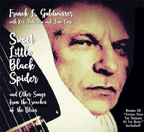 Franck
Goldwasser
Franck
Goldwasser
Sweet Little Black Spider
SlimByrd Records 2020
Franck Goldwasser is a name you quite possibly are unfamiliar with, but
it’s time to correct that situation. Also known as Paris Slim, a
nod to his birth there, Goldwasser has been a U.S. resident since 1983
and has appeared on innumerable albums, including several of his own,
as well as establishing himself as a highly valued session musician. He
is held in high esteem by fellow musicians. His various residencies in
Paris, Portland, OR, Los Angeles, and Oakland led to associations with
a mind-boggling list of elite blues artists: Sonny Rhodes, Mark Hummel,
Jimmy McCracklin, Charlie Musselwhite, Rick Estrin, James Harman, RJ Mischo,
Big Jack Johnson, Sunnyland Slim, Billy Boy Arnold, and Curtis Salgado…and
that’s just the tip of the iceberg.
A more than competent singer and songwriter, Goldwasser is most noted
for his guitar mastery. He is adept at jazzy guitar flourishes, but this
album focuses on his blues chops, with tinges of funk and rock. He is
supported by the cream of West Coast colleagues: drummer June Core, and
Kid Andersen, who plays bass and co-produced with Franck. The result is
thirteen tracks that vary in pacing but never flag in quality. Among them
are two versions of the topical “Tyranny Is Rising,” alluding
to a certain inhabitant of a high elected U.S. office. Goldwasser’s
opinion is declared in the track’s title, but regardless of one’s
own political position, the musical merit and conviction of the piece
is indisputable.
“Sweet Little Black Spider,” the title track, is probably
one of the only songs – and a love song, at that! - ever written
to a spider: “I woke up early one morning/I was feeling so awful
low/Found myself a brand new friend/Layin’ up in my bathroom window/
Singin’ about my black spider/Sure helps me take my mind off you….”
“Bring Me My Forty-five” and “Struggle in My Home Town”
mine blues-funk territory, the latter featuring Goldwasser adeptly playing
harmonica, and “She’s Hip” is a straight-on blues rocker.
Special mention must be made of one of the three instrumentals, “Blues
for Eddie Hazel”: a haunting slow blues, the moving tune is distinguished
by Franck’s dazzling guitar effects, including wah-wah pedal and
reverb; it’s like a poignant, meditative Ronnie Earl number with
technical embellishments. Speaking of echoes of other great guitarists:
“Nosluf’s Last Laugh,” another of the instrumentals,
recalls the late Hollywod Fats in its riffs and its impeccable combination
of rhythmicity and inventiveness.
As a bonus, the release adds another forty-five informative and amusing
minutes of Goldwasser reminiscing about his musical development and past
encounters with other bluesmen, over a varied, compelling series of backing
tunes.—Steve Daniels
 Anissa
Lea
Anissa
Lea
E&A Music Productions LLC
www.anissalea.com
She’s a little bit blues, a little bit jazz, a little bit pop and
a whole lotta soul! That pretty much sums up Detroit area singer-songwriter
Anissa Lea in a nutshell. But then when you realize she’s just 15
years old it definitely stops you in your tracks. That is largely due
to her sophisticated musical palette and self-assured vocal style evident
on this eponymous debut.
The CD/vinyl release has a rich, classic vibe, from the B&W album
cover to the warm analog sound. This girl’s got attitude right out
of the gate, with a song popularized by Peggy Lee called “Why Don’t
You Do Right.” The “Kansas Joe” McCoy composition is
a funky, bluesy cooker, with a jazzy lilt. Lea’s come hither charm
hits you like a ton of bricks. And her voice blends so well, with the
slithery saxophone of The Motor City Horn’s Keith Kaminski and the
drums of co-arranger Rob Emanuel. Lea summons the spirits of Billie Holiday
and Ella Fitzgerald for the ballad “Dream a Little Dream.”
Her phrasing is uncannily reverent to those aforementioned legends, yet
she makes it her own. Dwight Adams’ sweet muted trumpet and the
backing vocals of Arie Griggs and Herb Harris add to that vintage feel.
Sonny Burke’s “Black Coffee” is hands down ‘50s/’60s
cool. Lea takes some liberties scatting here and there over this swinging
samba groove. Sven Anderson’s solo piano and Kaminski’s baritone
sax are icing on the cake. And when the young chanteuse wraps up her vocal
with the line “my nerves have gone to pieces and my hair is turning
gray,” you tend to believe her! The Shangri-Las’ “Remember
Walking in the Sand” gets a jazzy redux, as Lea really wails on
this one. There are nice rhythmic transitions from the verses to a swinging
chorus. The mid-section features outstanding Latin-influenced solos by
trumpeter Justin Garrett Walker and guitarist Jerry Jenson. Continuing
with that ‘60s pop direction The Drifters’ “This Magic
Moment” spotlights a light bossa nova groove accompanied by Jenson’s
smooth Wes Montgomery/George Benson licks. Lea also knows how to take
a rubato vamp section and really run with it. Dinah Washington’s
“What a Difference a Day Makes” is a true show stopper. Lea’s
ability to capture the moment and weave her voice in and around the other
instruments is uncanny. This tune features strong leads on tenor from
Kaminski, with stellar Lambert, Hendricks and Ross styled backing vocals
from Harris and Griggs. Now “Can’t Take My Eyes Off of You”
has been done to death by every lounge act from here to Timbuktu. But
Lea and company give the classic Four Seasons’ hit new life. Her
voice is effervescent and floats above the fray of a mildly percolating
arrangement. The band takes some rhythmic liberties toward the finale
which is a nice touch as well. “Trapped Inside” is the only
original tune on the album and it holds its own in the set list. It is
written by Lea and her producer/manager Alex J. Greene. It’s a nice
slice of soul meets pop, dealing with powerful emotion and personal struggles.
There is a timeless Laura Nyro/Carole King component here that hints at
hearing much more from this songwriting team.
The final track on the album is unique in that it features outtakes from
the recording. Here Lea discusses the origins of each song and her personal
journey in discovering and recording them. It’s a fascinating aural
log into this young and very gifted artist. –Eric Harabadian
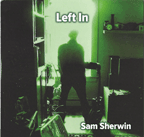 Sam
Sherwin
Sam
Sherwin
“Left In”
www.reverbnation.com/samsherwin
Sam Sherwin is an award-winning singer-songwriter that hails from New
Jersey by way of Detroit. Born in the Motor City, Sherwin moved to New
York City as a child and established a musical name on the NYC/NJ east
coast rock/Americana/blues and r&b circuit. He’s played all
the major clubs in NYC, including The Mercury Lounge, The R Bar, The China
Club and Sullivan Hall. But his heart has periodically brought him back
to Detroit to jam with cousin/guitar extraordinaire Jeff Grand and sit-ins
with The Detroit Cobras and The Howling Diablos.
This 4 song EP features a diverse and esteemed collective of musicians
such as keyboardist/producer Peter Vitalone (Garland Jeffrys, Les Paul),
backing vocalist Ray Frazier (David Byrne), backing vocalist Walter Parks
(Richie Havens), backing vocalist Janet LaBelle, bassist Bert Blind, percussionist/Kaleidoscope
Sound owner Randy Crafton and Grammy/American Music Award-nominated drummer
Aaron Comess of Spin Doctors. “Can’t Depend on You”
opens the disc, with Sherwin’s spare and unadorned acoustic guitar.
When the band kicks in Sherwin sets the scene of a carnival barker as
he describes the dynamics of a rocky relationship. The groove is direct
and spacious, with a very Phil Spector-ish wall of sound. The give and
take from vocalist LaBelle recalls some of Linda Ronstadt’s best
work. “Johnny Got Soul” is appropriately that, as Vitalone’s
boogie piano licks compliment Sherwin’s swinging rhythms. The soulful
groove of Comess volleys between four on the floor rock and a slightly
jazz feel. Ray Frazier’s smooth response in the chorus really gives
this one some spark. And Sherwin’s Eric Clapton/ Kim Simmonds-like
guitar break adds an incendiary urgency to the track. They slow things
down a bit for the touching ballad “Losing My Faith,” but
lose none of the album’s momentum. This has a surreal, and almost
gospel, feel, with the addition of Parks’ otherworldly falsetto.
There’s also a real Springsteen/Leon Russell contemplative vibe
to it. Vitalone’s piano and organ work here is amazingly sparse,
yet wonderfully textured. That brings us to the final track on the EP
called “The Wells Run Dry.” This is Sherwin at his bluesiest.
He erupts out of the gate, with a groove that recalls early Fleetwood
Mac spiced with Savoy Brown and John Lee Hooker. His guitar tone and solo
style is gruff, yet refined; bridging that gap where rock, blues and jazz
seamlessly meet. There are interesting tempo twists in the mid-section
that resolve, with a dense instrumental and layered vocal finale.--Eric
Harabadian ###
BOOK
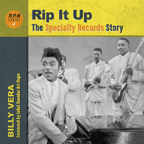 Rip
It Up:
Rip
It Up:
The Specialty Record Story
Billy Vera
BMG Books
Art Rupe’s Specialty Records was a commercially successful R&B
independent label in the 1950’s mainly due to chart-topping hits
by Guitar Slim, Lloyd Price, Little Richard and Larry Williams, but the
company’s impact actually went back to the mid-Forties. Founded
by Rupe in Los Angeles in 1946 as a derivative of his first venture, Juke
Box Records, Rupe had an out-of-the-box hit with Roy Milton’s “RM
Blues,” a truly leading-edge city blues record of the 1940’s,
that led him to more big bands performing ballads, blues and boogie numbers
that paid off with a chain of top-sellers by Joe Liggins, Camille Howard,
Jimmy Liggins and, of course, Roy Milton and his Solid Senders. Percy
Mayfield’s smoldering smash “Please Send Me Someone To Love”
began the Fifties in fine fashion but the hip Rupe sensed his West Coast
recordings were getting stale so he took a field trip down South to New
Orleans looking for fresh blues and R&B material, returning with the
master of Lloyd Price’s “Lawdy Miss Clawdy” which sold
over a million and was the top R&B record of 1952. Similarly, Guitar
Slim’s debut disc for Specialty, the quintessential “The Things
That I Used To Do” also sold a million but Rupe’s raid on
New Orleans was only complete when behind-the-scenes, Crescent City producers
(Robert “Bumps” Blackwell, Sonny Bono and Harold Battiste)
gave Little Richard that idiosyncratic sound that made the frenzied “Tutti
Frutti” a nationwide hit in 1955. The extroverted showman followed
with a string of successes with titles like “Long Tall Sally,”
“Keep A Knockin’,” “Lucille” and “Good
Golly Miss Molly” before he took that fateful airplane ride. In
addition to R&B and the up-and-coming sounds of rock ‘n’
roll, from the likes of Larry “Short Fat Fannie” Williams,
Don and Dewey (“Justine”) and Jerry Byrne (with his manic
“Lights Out” featuring Art Neville’s mind-melding guitar
solo, Rupe was also especially attracted to Black gospel music with a
roster that encompassed Sam Cooke’s Soul Stirrers, Sister Wynona
Carr, Brother Joe May and Alex Bradford among others. Vera’s easy-reading
telling of the tale benefits greatly from his thirty year friendship with
the memory-rich, “hands on” Rupe as well as conversations
with the few remaining artists (lots of Little Richard) and fact-filled
mini-biographies of the bustling music scenesters and performers. As Vera
cogently puts it in his introduction “ What follows is the story
of a label, its founder, and its artists who, together, contributed as
much to mid-century music as the Atlantics, the Chesses, the Suns, and
the rest, taking an esoteric form of music and bringing it to the masses—music
that lives on more than half a century later.” Can’t argue
with that. 16 great photos is the icing on the cake.—Gary von Tersch
Home
/ Blues Blogs /
Artist Links / Blues
Links / Videos / Store
Subscribe / Advertise
/ Back Issues
/ Contact / Staff